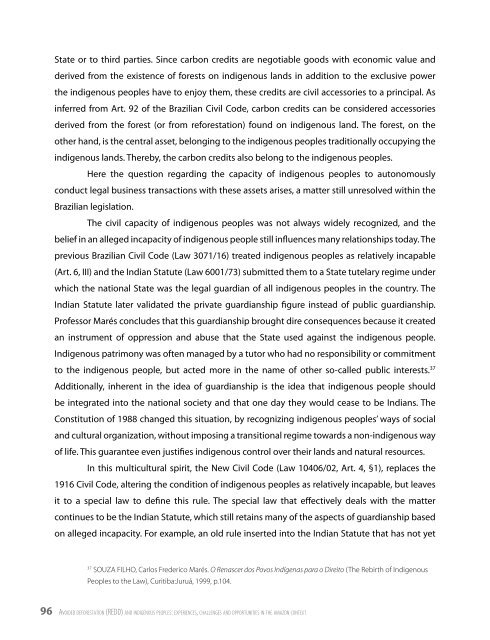Avoided Deforestation (REDD) and Indigenous ... - Amazon Fund
Avoided Deforestation (REDD) and Indigenous ... - Amazon Fund
Avoided Deforestation (REDD) and Indigenous ... - Amazon Fund
You also want an ePaper? Increase the reach of your titles
YUMPU automatically turns print PDFs into web optimized ePapers that Google loves.
State or to third parties. Since carbon credits are negotiable goods with economic value <strong>and</strong><br />
derived from the existence of forests on indigenous l<strong>and</strong>s in addition to the exclusive power<br />
the indigenous peoples have to enjoy them, these credits are civil accessories to a principal. As<br />
inferred from Art. 92 of the Brazilian Civil Code, carbon credits can be considered accessories<br />
derived from the forest (or from reforestation) found on indigenous l<strong>and</strong>. The forest, on the<br />
other h<strong>and</strong>, is the central asset, belonging to the indigenous peoples traditionally occupying the<br />
indigenous l<strong>and</strong>s. Thereby, the carbon credits also belong to the indigenous peoples.<br />
Here the question regarding the capacity of indigenous peoples to autonomously<br />
conduct legal business transactions with these assets arises, a matter still unresolved within the<br />
Brazilian legislation.<br />
The civil capacity of indigenous peoples was not always widely recognized, <strong>and</strong> the<br />
belief in an alleged incapacity of indigenous people still influences many relationships today. The<br />
previous Brazilian Civil Code (Law 3071/16) treated indigenous peoples as relatively incapable<br />
(Art. 6, III) <strong>and</strong> the Indian Statute (Law 6001/73) submitted them to a State tutelary regime under<br />
which the national State was the legal guardian of all indigenous peoples in the country. The<br />
Indian Statute later validated the private guardianship figure instead of public guardianship.<br />
Professor Marés concludes that this guardianship brought dire consequences because it created<br />
an instrument of oppression <strong>and</strong> abuse that the State used against the indigenous people.<br />
<strong>Indigenous</strong> patrimony was often managed by a tutor who had no responsibility or commitment<br />
to the indigenous people, but acted more in the name of other so-called public interests. 37<br />
Additionally, inherent in the idea of guardianship is the idea that indigenous people should<br />
be integrated into the national society <strong>and</strong> that one day they would cease to be Indians. The<br />
Constitution of 1988 changed this situation, by recognizing indigenous peoples’ ways of social<br />
<strong>and</strong> cultural organization, without imposing a transitional regime towards a non-indigenous way<br />
of life. This guarantee even justifies indigenous control over their l<strong>and</strong>s <strong>and</strong> natural resources.<br />
In this multicultural spirit, the New Civil Code (Law 10406/02, Art. 4, §1), replaces the<br />
1916 Civil Code, altering the condition of indigenous peoples as relatively incapable, but leaves<br />
it to a special law to define this rule. The special law that effectively deals with the matter<br />
continues to be the Indian Statute, which still retains many of the aspects of guardianship based<br />
on alleged incapacity. For example, an old rule inserted into the Indian Statute that has not yet<br />
37 SOUZA FILHO, Carlos Frederico Marés. O Renascer dos Povos Indígenas para o Direito (The Rebirth of <strong>Indigenous</strong><br />
Peoples to the Law), Curitiba:Juruá, 1999, p.104.<br />
96 Av o i d e d d e f o re s t A t i o n (redd) A n d i n d i g e n o u s p e o p l e s: experiences, chAllenges A n d o p p o r t u n i t i e s in t h e A m A zo n c o n t e x t
















